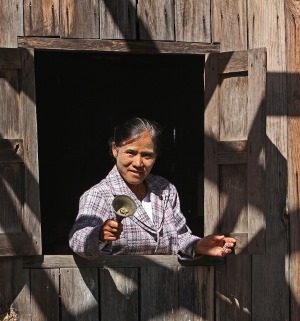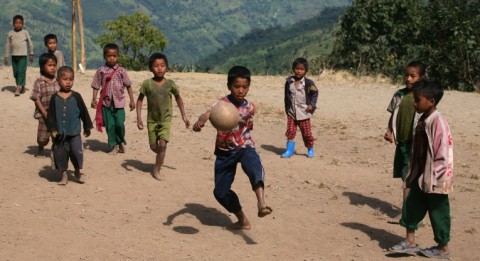Village school struggling to get by without enough teachers
When Daw Om Yawmg, 59, rings her bell from an open window, the children of the Kyar Don village school stop their ball games and run back inside from their break. There is one teacher and one volunteer for 140 children.
The village of Kyar Don is located in Chin State, a couple of hours’ walk from the township of Mindat, in poor rural region of Myanmar. The village houses are built in a valley and on the slopes of the surrounding hills. A clear river runs through the valley. Visitors are greeted by lush vegetation full of beautiful flowers and colourful butterflies.
The Kyar Don village school is built high up on a hill. The school consists of a single large classroom, where students sit on benches at small tables. The first and second year students are grouped together.
Proportion of girls on the rise
”The school has nearly a hundred students, from first to fifth year, and another 40 or so nursery school students. Some of the schoolchildren live nearby, but some have to walk to school from three to four kilometres away,” says the teacher, Daw Om Yawmg. In the rough terrain, the trip to school and back can take several hours each day.
Daw Om Yawmg has over 35 years of teaching experience. She graduated as a teacher after a year of studies. A lot has changed since then.
”Back in the old days, parents mainly sent their boys to school. Nowadays there are a lot more girls, even though the majority of students are still boys,” says Daw Om Yawmg.
Myanmar language classes most important
According to Daw Om Yawmg, the most important school subject is the Myanmar language (also known Burmese), reading and writing.
The residents of Kyar Don village are part of the Muun tribe, which is one of over 50 tribes residing in Chin State. The village school teaches new students both the local and the country’s official language.
In addition to the Myanmar language, students are taught English and mathematics. In fourth and fifth year, students also study history and geography.
Besides Daw Om Yawmg, there is only one other full-time teacher at the school. The school also employs a third, unqualified teacher, who has not yet finished their studies. Lastly there is a volunteer assistant who works for food, which is provided by the villagers.
“Considering the number of students, we need more teachers at the school“, admits Daw Om Yawmg.
Whole day without food
The children arrive at the school at 8:30am for breakfast, which they have to bring from home. School ends at 3pm.
”Food is a problem since not all children bring lunches with them. After breakfast, these children don’t get another meal until they return home from school. And even if the children bring a meal, there’s not always enough food. Often the food is also not nutritious enough”, says Daw Om Yawmg.
The state provides first graders with textbooks, but for subsequent grades, the students have to buy their own books. For many families, this is a large expense, sometimes large enough to prevent schooling altogether. The school should provide students with writing materials, but pencils, erasers and notebooks are often in short supply. Among other things, Finn Church Aid’s partner The Lutheran World Federation assists schools with material procurements.
Text: Riitta Saarinen
Photos: Petteri Kokkonen

